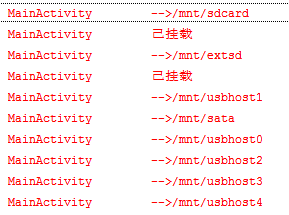直接上重点:
1:获取内置SD卡的路径, 但是判断是否有效(是否挂载), 需要用到下面检测挂载点的方法
/**
* 获取内置SD卡路径
*
* @return
*/
public String getInnerSDCardPath() {
return Environment.getExternalStorageDirectory().getPath();
}
2:枚举系统所有可用的挂载点,返回的都是绝对路径
/** 枚举所有挂载点 */
public static String[] getVolumePaths(Context context) {
String[] paths = null;
StorageManager mStorageManager;
Method mMethodGetPaths = null;
try {
mStorageManager = (StorageManager) context
.getSystemService(Activity.STORAGE_SERVICE);
mMethodGetPaths = mStorageManager.getClass().getMethod(
"getVolumePaths");
paths = (String[]) mMethodGetPaths.invoke(mStorageManager);
} catch (Exception e) {
e.printStackTrace();
}
return paths;
}
我的运行结果如下:
(图中中文是检测挂载的方法log输出)
3:检测挂载点是否可用
/**
* 检查是否挂载
*/
public static boolean checkMounted(Context context, String mountPoint) {
if (mountPoint == null) {
return false;
}
StorageManager storageManager = (StorageManager) context
.getSystemService(Context.STORAGE_SERVICE);
try {
Method getVolumeState = storageManager.getClass().getMethod(
"getVolumeState", String.class);
String state = (String) getVolumeState.invoke(storageManager,
mountPoint);
return Environment.MEDIA_MOUNTED.equals(state);
} catch (Exception e) {
e.printStackTrace();
}
return false;
}
(截图如上,如果已挂载,返回true)
SD卡广播:
//在AndroidManifest.xml文件中,声明广播
public class SDBroadCastReceiver extends BroadcastReceiver {
@Override
public void onReceive(Context context, Intent intent) {
String action = intent.getAction();
if (action.equals(Intent.ACTION_MEDIA_EJECT)) {
Log.e(context.getClass().getSimpleName(), "SD卡已拔出");
} else if (action.equals(Intent.ACTION_MEDIA_MOUNTED)) {
Log.e(context.getClass().getSimpleName(), "SD卡挂载");
}
}
}
补充说明, 这里测试环境是Android 4.2.2, API 17
/mnt/sdcard :这是内置SD卡的路径(也是挂载点);(不同Android版本,可能不一样)
/mnt/extsd :这是外置SD卡的路径(也是挂载点);
所以:
如果要检测内置/外置SD卡是否存在(可用),方法如下:
if (checkMounted(MainActivity.this, "/mnt/sdcard")) {
Log.e(this.getLocalClassName(), "内置SD卡可用");
}
if (checkMounted(MainActivity.this, "/mnt/extsd")) {
Log.e(this.getLocalClassName(), "外置SD卡可用");
}
简单介绍 Java反射的用法:
1:获取需要反射的对象(需要修改属性,或者需要调用非公隐藏方法的对象):
StorageManager storageManager = (StorageManager) context.getSystemService(Context.STORAGE_SERVICE);
2:得到对象需要调用的方法或者字段的名称
//得到 方法名称,这个方法必须是public声明的才能获取,如果要获取非公方法名,需要使用getDeclaredMethods方法
Method getVolumeState = storageManager.getClass().getMethod("getVolumeState", String.class);//第一个参数:方法的名称, 第二个参数:方法的参数
//得到 字段名,这里用了getDeclaredField方法,所以可以得到非公声明的字段
Field tag = storageManager.getClass().getDeclaredField("TAG");
tag.setAccessible(true);//因为可能字段是非公有,所以需要设置访问权限为公有
tag.set(storageManager, "New Tag");//修改字段的值
3:调用方法(字段赋值,前面已经说了)
String state = (String) getVolumeState.invoke(storageManager,mountPoint);
//storageManager :是需要修改的对象
//mountPoint :方法需要的参数
至此: 文章就结束了,如有疑问: QQ群:274306954 欢迎您的加入.
